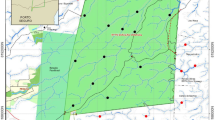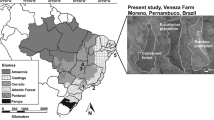Abstract
The high-altitude wet forests of northeastern Brazil, locally known as “Brejos de Altitude,” are enclaves of the Atlantic Forest situated above 500 m, surrounded by dryland vegetation, the Caatinga. The aim of this study was to characterize drosophilid communities in these upland forests, since few ecological studies on drosophilid communities have been conducted in northeastern Brazil. Four sites were investigated in three different times of the year throughout standardized traps. The results reveal the presence of 55 different species in a total of 13,064 specimens collected. The data were evaluated using ecological diversity measurements and compared with those obtained for other environments in the same geographic region. As for species composition, the Bonito upland forest, in a boundary forest location, stood out as having high species richness.




Similar content being viewed by others
References
Andrade-Lima D (1966) Esboço fitoecológico de alguns “brejos” de Pernambuco. Bol Tec / Inst Pesqui Agron Pernamb 8:3–10
Avondet J, Blair RB, Berg DJ, Ebbert MA (2003) Drosophila (Diptera: Drosophilidae) response to changes in ecological parameters across an urban gradient. J Environ Biol 32:347–358
Bächli G, Vilela CR, Escher SA, Saura A (2004) The Drosophilidae (Diptera) of Fennoscandia and Denmark. Fauna Entomol Scand 39:1–362
Balanya J, Oller JM, Huey RB, Gilchrist GW, Serra L (2006) Global genetic change tracks global climate warming in Drosophila subobscura. Science 313:1773–1775
Bizzo NMV, Sene FM (1982) Studies on the natural populations of Drosophila from Peruibe (SP) Brazil (Diptera, Drosophilidae). Rev Bras Biol 42:539–544
Breuer ME, Pavan C (1950) Genitália masculina de Drosophila (Diptera): Grupo annulimana. Rev Bras Biol 10:469–488
Carson HL (1971) The ecology of Drosophila breeding sites. In: Harold L (ed) Lyon Arboretum Lecture Number 2. The University of Hawaii, Honolulu, pp 1–27
Cavasini R, Buschini MLT, Machado LPB, Mateus RP (2014) Comparison of Drosophilidae (Diptera) assemblages from two highland Araucaria Forest fragments, with and without environmental conservation policies. Braz J Biol 74:761–768
Chaves NB, Tidon R (2008) Biogeographical aspects of drosophilids (Diptera, Drosophilidae) of the Brazilian savanna. Rev Bras Entomol 52:340–348
De Toni DC, Gottschalk MS, Cordeiro J, Hofmann PPR, Valente VLS (2007) Study of the Drosophilidae (Diptera) communities on Atlantic Forest islands of Santa Catarina state, Brazil. Neotrop Entomol 36:356–375
Dobzhansky T, Pavan C (1950) Local and seasonal variations in relative frequencies of species of Drosophila in Brazil. J Anim Ecol 19:1–14
Döge JS, Valente VLS, Hofmann PRP (2008) Drosophilids (Diptera) from an Atlantic Forest area in Santa Catarina, Southern Brazil. Rev Bras Entomol 52:615–624
Foote D, Carson HL (1995) Drosophila as monitors of change in Hawaiian ecosystems. In: LaRoe, Farris GS, Puckett CE, Doran PD, Mac MJ (eds) Our living resources: a report to the nation on the distribution, abundance, and health of US plants, animals, and ecosystems. National Biological Service, Washington, DC: Department of the Interior, pp 368–372, 530 p
Freire-Maia N, Pavan C (1949) Introdução ao estudo da drosófila. Cultus 1:1–171
Gottschalk MS, De Toni DC, Hofmann PRP, Valente VLS (2007) Changes in Brazilian Drosophilidae (Diptera) assemblages across an urbanization gradient. Neotrop Entomol 36:848–862
Gottschalk MS, Hofmann PRP, Valente VLS (2008) Diptera, Drosophilidae: historical occurrence in Brazil. Check List 4:485–518
Grimaldi DA (1990) A phylogenetic, revised classification of genera in the Drosophilidae (Diptera). Bull Am Mus Nat Hist 197:103–268
Hammer Ø, Harper DAT, Ryan PD (2001) PAST: paleontological statistics software package for education and data analysis. http://palaeo-electronica.org/2001_1/past/issue1_01.htm. Accessed 01 June 2015
Krebs CJ (1999) Ecological methodology, 2nd edn. Addison Wesley Longman Inc, New York
Lucchese MEP, Flores FEV, Valente VLS (2002) Drosophila as bioindicator of air pollution: preliminary evaluation of the wild species D. willistoni. Rev Bras Biocienc 1:19–28
Malogolowkin C (1952) Sobre a genitália dos “Drosophilidae” (Diptera). III. Grupo willistoni do gênero Drosophila. Rev Bras Biol 12:79–96
Markow TA, O’Grady P (2006) Drosophila: a guide to species identification and use. Academic Press (Elsevier), London
Martins MB (2001) Drosophilid fruit-fly guilds in forest fragments. In: Bierregaard RO Jr, Gascon C, Lovejoy TE, Mesquita RCG (eds) Lessons from Amazonia: the ecology and conservation of a fragmented forest. Yale University Press, New Haven, pp 175–186
Mata RA, Mcgeoch M, Tindon R (2008) Drosophilid assemblages as a bioindicator system of human disturbance in the Brazilian Savanna. Biodivers Conserv 17:2899–2916
Mata RA, Tidon R, Côrtes LG, De Marco JP, Finiz-Filho JAF (2010a) Invasive and flexible: niche shift in the drosophilid Zaprionus indianus (Insecta, Diptera). Biol Invasions 12:1231–1249
Mata RA, McGeoch M, Tidon R (2010b) Drosophilids (Insecta, Diptera) as tools for conservation biology. Nat Conserv 8:60–65
Mata RA, Valadao H, Tidon R (2015) Spatial and temporal dynamics of drosophilid larval assemblages associated to fruits. Rev Bras Entomol 59:50–57
McAleece N, Gage JDG, Lambshead PJD, Paterson GLJ (1997) BioDiversity Professional statistics analysis. http://www.smi.ac.uk/peter-lamont/biodiversity-pro. Accessed 14 Nov 2011
Medeiros HF, Klaczko LB (2004) How many species of Drosophila (Diptera, Drosophilidae) remain to be described in the forests of São Paulo, Brazil? Species lists of three forest remnants. Biota Neotropica 4(1):1–12
Monteiro LS, Cabral WBM, Montes MA, Garcia ACL, Rohde C (2014) Occurrence of the genus Zygothrica (Diptera, Drosophilidae) in a high-altitude forest in Northeastern Brazil. Drosoph Inf Serv 97:15–17
Paiva MP, Campos E (1995) Fauna do Nordeste do Brasil: conhecimento científico e popular. Banco do Nordeste do Brasil, Fortaleza, p 274
Parsons PA (1991) Biodiversity conservation under global climatic change: the insect Drosophila as a biological indicator? Glob Ecol Biogeogr Lett 1:1195–1198
Poppe JL, Schmitz HJ, Grimaldi D, Valente VLS (2014) High diversity of Drosophilidae (Insecta, Diptera) in the Pampas biome of South America, with descriptions of new Rhinoleucophenga species. Zootaxa 3779(2):215–245
Porto KC, Cabral JJS, Tabarelli M (2004) Brejos de Altitude em Pernambuco e Paraíba: história natural, ecologia e conservação, 1 ed Ministério do Meio Ambiente, Brasília DF (série Biodiversidade, n. 9) 324 p
Powell JR (1997) Progress and prospects in evolutionary biology: the Drosophila model. Oxford University Press, Oxford
Rohde C, Monteiro AGF, Cabral WBM, Silva DMIO, Oliveira GF, Montes MA, Garcia ACL (2010) The importance of identification of the willistoni subgroup of Drosophila at the species level: the first evidence of D. equinoxialis in the Northeast region of Brazil. Drosoph Inf Serv 93:118–122
Rohde C, Silva DMIO, Oliveira GF, Monteiro LS, Montes MA, Garcia ACL (2014) Richness and abundance of the cardini group of Drosophila (Diptera, Drosophilidae) in the Caatinga and Atlantic Forest biomes in northeastern Brazil. An Acad Bras Cienc 86(4):1711–1718
Schmitz HJ, Valente VLS, Hofmann PRP (2007) Taxonomic survey of Drosophilidae (Diptera) from mangrove forests of Santa Catarina Island, southern Brazil. Neotrop Entomol 36:53–64
Schmitz HJ, Hofmann PRP, Valente VLS (2010) Assemblages of drosophilids (Diptera, Drosophilidae) in mangrove forests: community ecology and species diversity. Iheringia Sér Zool 100(2):133–140
Silva NM, Fantinel CC, Valente VLS, Valiati VH (2005) Population dynamics of the invasive species Zaprionus indianus (Gupta) (Diptera, Drosophilidae) in communities of drosophilids of Porto Alegre city, Southern of Brazil. Neotrop Entomol 34:363–374
Tidon R, Sene FM (1988) A trap that retains and keeps Drosophila alive. Drosoph Inf Serv 67:89
Tidon-Sklorz R, Sene FM (1999) Diptera: Drosophila. In: Brandão CRF, Cancello EM (eds) Biodiversidade do Estado de São Paulo: I Síntese do conhecimento ao final do século XX. Fundação de Amparo à Pesquisa do Estado de São Paulo, São Paulo, pp 245–261
Val FC (1982) The male genitalia of some Neotropical Drosophila: notes and illustrations. Pap Avulsos Zool 34:309–347
Vasconcelos Sobrinho J (1971) As regiões naturais do Nordeste, o meio e a civilização. Conselho do Desenvolvimento de Pernambuco, Recife, p 441
Vilela CR (1983) A revision of the Drosophila repleta species group (Diptera, Drosophilidae). Rev Bras Entomol 27:1–114
Vilela CR, Bächli G (1990) Taxonomic studies on Neotropical species of seven genera of Drosophilidae (Diptera). Mitt Schweiz Entomol Ges 63:1–332
Vilela CR, Val FC (1985) The male genitalia of six members of the Drosophila tripunctata species group (Diptera, Drosophilidae). Rev Bras Entomol 9:503–514
Wheeler MR (1952) XI The Drosophilidae of the Nearctic region, exclusive of the genus Drosophila. In: Patterson JT (ed) Studies in the genetics of Drosophila. VII. Further articles on genetics, cytology and taxonomy. The University of Texas, Austin, pp 162–218
Wheeler MR (1986) Additions to the catalog of the world's Drosophilidae. In: Ashburner M, Carson HL, Thompson JN Jr (eds) The genetics and biology of Drosophila. Academic Press, London, pp 395–409
Acknowledgments
The authors are grateful to the funding agencies Fundação de Amparo à Ciência e Tecnologia do Estado de Pernambuco (FACEPE), Pró-Reitoria para Assuntos de Pesquisa e Pós-Graduação, Universidade Federal de Pernambuco (PROPESQ-UFPE), and Conselho Nacional de Desenvolvimento Científico e Tecnológico (CNPq) for fellowships and grants.
Author information
Authors and Affiliations
Corresponding author
Additional information
Edited by Wesley AC Godoy – ESALQ/USP
Electronic supplementary material
Below is the link to the electronic supplementary material.
ESM 1
(DOCX 135 kb)
Rights and permissions
About this article
Cite this article
Monteiro, L.S., Garcia, A.C.L., Oliveira, G.F. et al. High Diversity of Drosophilidae in High-Altitude Wet Forests in Northeastern Brazil. Neotrop Entomol 45, 265–273 (2016). https://doi.org/10.1007/s13744-016-0364-3
Received:
Accepted:
Published:
Issue Date:
DOI: https://doi.org/10.1007/s13744-016-0364-3




